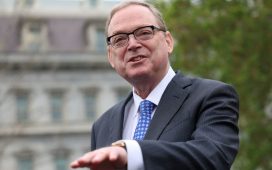Unlock the White House Watch newsletter for free
Your guide to what the 2024 US election means for Washington and the world
The Federal Reserve is not expected to cut interest rates on Wednesday but the US central bank’s policy is already under scrutiny from President Donald Trump.
Investors overwhelmingly expect the Fed to hold rates at their current level of 4.25-4.5 per cent, after three consecutive cuts since September.
Attention will focus on any shift in outlook from the accompanying statement, and on remarks from chair Jay Powell in the subsequent press conference.
In December the Fed signalled a likely pause in rate cuts and said it would consider the “extent and timing” of any further changes. Since then, data has shown slowing inflation and solid jobs growth — a combination that has sparked debate over the need for, and timing of, any further rate cuts.
“If the [Fed] wanted to send a further hawkish signal in January, this sentence could be modified again,” said HSBC US economist Ryan Wang. “We expect the Fed to refrain from sending such a signal, but this is a hawkish risk.”
But Powell is likely to face questions on early actions and comments from Trump, who this week said he would demand that interest rates drop. The president also called for lower oil prices, which could also affect inflation.
Trump has previously called for Powell’s exit but both have downplayed any friction since November’s election.
The Fed chair also made it clear in November he planned to serve out his current term and maintained too that the president could not remove him. Jennifer Hughes
Will the ECB signal a more aggressive interest rate policy?
After European Central Bank President Christine Lagarde last month came closer than ever to calling victory over inflation, investors are expecting another interest rate cut on Thursday.
Markets have fully priced in another 0.25 percentage point rate cut from policymakers in Frankfurt. If confirmed, that would be the fifth such reduction since June and would take the key deposit rate to 2.75 per cent, the lowest level in almost two years and 1.25 percentage points lower than at its peak in 2024.
In doing so, markets expect the ECB to discount December’s jump in annual inflation back to 2.4 per cent. It is confident that annual price increases this year will be close to its medium-term target of 2 per cent, while economic growth is likely to disappoint.
But almost half of the 72 participants in a Financial Times survey among European economists said that the ECB had been too slow in lowering rates.
“We do not see ourselves behind the curve,” Lagarde told CNBC in an interview in Davos this week where she attended the World Economic Forum.
Traders are expecting two or three further quarter-point cuts this year, according to levels implied by swaps markets.
With the US Fed becoming much more hawkish in December, a growing transatlantic gap in monetary policy appears to be opening up.
Lagarde told CNBC that the ECB was not “overly concerned” about potential repercussions for Europe from a potential uptick in inflation in the US. Olaf Storbeck
Will the Bank of Canada cut rates?
Traders are widely expecting the Bank of Canada to cut interest rates by a quarter point at Wednesday’s policy-setting meeting but a small question mark remains, given recent trends in economic data.
Swaps markets are pricing in a 90 per cent probability the central bank will cut its benchmark rate by 0.25 percentage points to 3 per cent from 3.25 per cent.
But when the Bank of Canada took half a percentage point off its overnight rate in December for the second meeting in a row, responding to weaker than expected economic growth, deliberations from its governing council showed that the decision between a quarter-point and half-point cut was a “close call” given mixed data and noted the “substantial” cumulation of recent reductions.
Members would be evaluating the need for further reductions in the policy rate “one meeting at a time”, the bank said in a summary of their deliberations, and “expected a more gradual approach to monetary policy going forward”.
Data since then show that Canada’s economy was growing “roughly in line” with the central bank’s forecast, according to Capital Economics. It also highlighted inflation data for December, that while including a decline to 1.8 per cent in the headline rate, indicated that a measure of underlying inflation trends was “uncomfortably high”.
Such pressures could give the central bank, which has also cited uncertainty created by the new US administration, the grounds to pause its rate cuts.
“With tariffs clouding the economic outlook, we judge that the governing council will opt for a [quarter-point] policy rate cut,” said Thomas Ryan, North America economist at Capital Economics. Ian Smith







